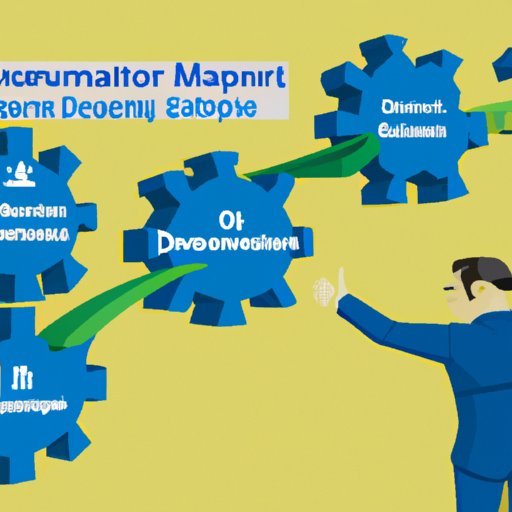Introduction
Business development managers (BDMs) are responsible for the growth of a company or organization. They are tasked with identifying potential opportunities and developing strategies to capitalize on them. It is their job to ensure that the organization is able to achieve its goals and objectives. To be successful in this role, BDMs must have a deep understanding of their industry, the competitive landscape, and the needs of their target markets.
This article will provide a comprehensive guide to becoming an effective business development manager. We will discuss the importance of developing a clear vision and strategic plan, building strong relationships with key stakeholders, utilizing effective communication strategies, leveraging data-driven decision-making, cultivating a positive team environment, and remaining adaptable to changing market conditions.

Develop a Clear Vision and Strategic Plan
The first step in becoming an effective BDM is to develop a clear vision and strategic plan. This involves identifying the goals and objectives of the organization, developing strategies to achieve those goals, and creating tactics to implement those strategies. A well-defined vision and plan provides direction and helps to ensure that all efforts are directed towards achieving the desired outcome.
When developing a vision and plan, it is important to consider the long-term implications of each decision. A successful BDM will take the time to research and analyze the current market conditions and identify any potential opportunities that can be leveraged to the organization’s advantage. They should also be aware of any risks associated with their decisions and be prepared to adjust their strategy accordingly.
Build Strong Relationships with Key Stakeholders
In order to be successful, BDMs must also be able to build strong relationships with key stakeholders. This includes customers, suppliers, partners, and other businesses in the same industry. Establishing connections with these individuals and organizations is essential for gaining insight into the industry and staying up-to-date with market trends.
Maintaining open communication is also critical for building strong relationships. BDMs should take the time to listen to the concerns of their stakeholders and understand their perspectives. They should also be willing to provide feedback and suggestions for improvement. By doing so, they will be better positioned to identify areas where the organization can make changes to better serve their customers.
Utilize Effective Communication Strategies
Effective communication is key to success as a BDM. The ability to communicate clearly and concisely is necessary for conveying information and ideas, as well as for inspiring others to take action. BDMs should strive to use language that is both accurate and persuasive, while also being mindful of cultural nuances.
Additionally, BDMs should be aware of different perspectives and be able to adjust their message accordingly. Understanding how different audiences may interpret the same information can help to ensure that the desired outcome is achieved. Lastly, BDMs should strive to make an impact with their words, as this will help to differentiate them from their competitors.
Leverage Data-Driven Decision-Making
Data-driven decision-making is an essential skill for any BDM. In today’s highly competitive marketplace, it is essential to be able to collect and analyze data in order to make informed decisions. BDMs should be familiar with the various data collection methods available, such as surveys, interviews, and focus groups. They should also be knowledgeable about the different types of data analysis techniques, such as descriptive statistics and regression analysis.
By leveraging data-driven decision-making, BDMs will be better equipped to identify opportunities, develop strategies, and make informed decisions. This will enable them to remain agile and responsive to changing market conditions. Additionally, it will help them to stay ahead of the competition and ensure that their organization remains competitive.

Cultivate a Positive Team Environment
BDMs must also be able to foster a positive team environment. This involves encouraging collaboration among team members, celebrating achievements, and fostering mutual respect. A positive team environment is essential for ensuring that everyone is working together towards a common goal. Additionally, it helps to create an atmosphere of trust and openness, which can lead to more creative solutions and better results.
Team building exercises can be used to help foster a positive team environment. These activities can range from simple icebreakers to more complex problem-solving activities. The goal is to get team members interacting with each other and working together to solve problems. By doing so, BDMs can ensure that their team is motivated and productive.

Remain Adaptable to Changing Market Conditions
Finally, BDMs must remain adaptable to changing market conditions. This means monitoring changes in the industry, adjusting strategies as needed, and staying ahead of the curve. It is essential for BDMs to be able to anticipate and respond to shifts in the market in order to remain competitive.
To do so, BDMs should be familiar with the latest trends and technologies in their industry. Additionally, they should be prepared to adjust their strategies based on customer feedback and changes in the competitive landscape. By remaining adaptable, BDMs will be better positioned to capitalize on new opportunities and ensure that their organization remains successful.
Conclusion
Being an effective business development manager requires a variety of skills and qualities. BDMs must be able to develop a clear vision and strategic plan, build strong relationships with key stakeholders, utilize effective communication strategies, leverage data-driven decision-making, cultivate a positive team environment, and remain adaptable to changing market conditions. By doing so, they will be better positioned to lead their organization to success.
(Note: Is this article not meeting your expectations? Do you have knowledge or insights to share? Unlock new opportunities and expand your reach by joining our authors team. Click Registration to join us and share your expertise with our readers.)
